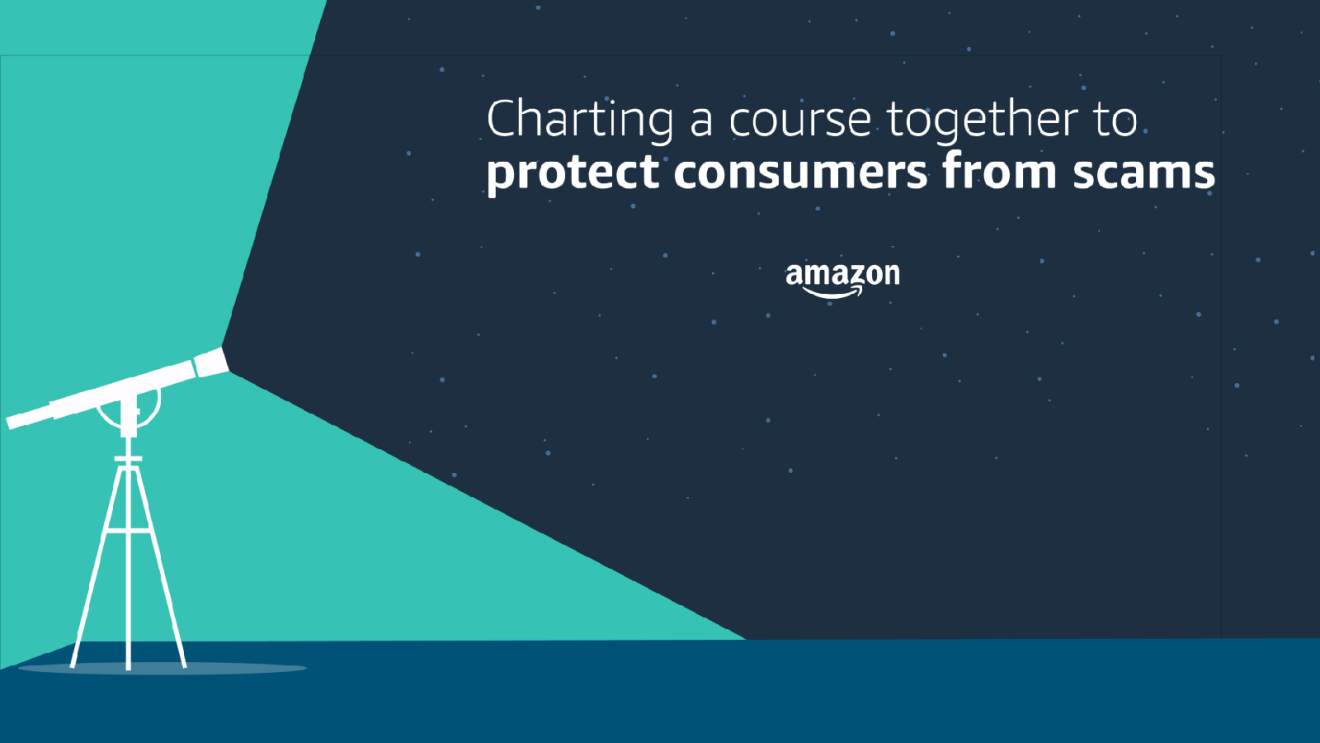Amazon strives to be Earth’s most customer-centric company, which includes ensuring that scammers are not using our brand to take advantage of people who trust us. Our vision is to build a world where consumers are confident that they won’t fall prey to bad actors who impersonate our brand or anyone else’s. We believe this is the right thing to do for our customers, and all consumers, especially given the global, cross-industry nature of this challenge.
While scams are not a new problem, the opportunities for scammers to commit their crimes have increased due to the rise of internet adoption makes it convenient for consumers to run many aspects of their daily lives and greater access to sophisticated technologies. Scammers use a combination of sophisticated techniques as well as social engineering to exploit consumer trust.
Using unsolicited contact via email, phone calls, text, social media, and other communication tools, scammers pretend to be legitimate, well-known brands and institutions, like Amazon, and design scams that manipulate victims. Unfortunately, scammers’ schemes continue to succeed in stealing from consumers. The US Federal Trade Commission (FTC) found that American consumers lost nearly $8.8 billion to scams in 2022 and the Global Anti-Scam Alliance’s Global State of Scams Report estimates that consumers lost over $1 trillion globally in 2023. Scammers are constantly refining their tactics, forcing those working to stop them to remain vigilant.
In response, governments around the world are becoming more creative and more focused on getting to the heart of the problem, setting up anti-scam focused departments, like the National Anti-Scam Centre in Australia, and establishing initiatives for greater cross-sector collaboration, like the UK Online Fraud Charter of which Amazon is a signatory. Similar efforts are gaining traction in other countries, like Italy, Japan, Singapore, and South Africa. From banking to retail, to telecommunications providers, the private sector is also working to anticipate these bad actors, each tackling the challenge from their vantage point.

At Amazon, we consistently work to protect our customers from scams by building innovative technologies that shield accounts and detect fraudulent attempts, creating educational initiatives to help consumers know it’s really us, and fostering partnerships with law enforcement to hold bad actors accountable. We have teams of machine learning scientists, software developers, and expert investigators around the globe dedicated to protecting customers from scams like these, and their efforts are having an impact. These teams proactively identify and take down fraudulent websites and phone numbers by monitoring as well as reviewing customer reports.
Of all the scams impersonating Amazon reported by our customers globally in 2023, over two-thirds of scams claimed to be related to order or account issues. These reports often include interactions with scammers where a customer tells us, “I got a random call from someone who claimed I bought something on Amazon that I hadn’t and they wanted my account information to verify this was an error.” In 2023, we saw more than a 15% decrease in customers who fell victim to scams. Still, no one is immune to scams, nor should anyone feel embarrassment when they are targeted by scammers. In fact, as these scams happen outside our store and our protected communication channels, the more consumers report scams to us, the better our tools get at identifying those responsible so that we can work to stop them. We are continuing to develop solutions and innovate on behalf of customers to address this shared challenge alongside others.
While these steps help, protecting consumers around the world will require activation of the entire scam-fighting community to work across jurisdictions and sectors. At Amazon, we listen to feedback from our customers and engage in rich discussions with scam prevention leaders. There are two themes that consistently arise in these conversations—stopping scams at the source and helping consumers avoid and recover from scams when they need it most. Amazon does not have all the solutions to these issues, but we want to work with others interested in exploring cross-sector solutions to address them.

1. Work across silos to stop scams at the source
Understanding the true scope and reach of scams is challenging. Scammers use multiple legitimate services of trusted entities all over the world to make it even harder. Often, each organization whose service or brand is being used, or jurisdiction in which these scams are executed, only sees a part of the full spectrum of scam activity taking place. With limited information, each works to stop the bad actors and disable their infrastructure as best as they can. Without scaled solutions and timely information, these efforts help thwart scammers temporarily but stop short of holding them accountable and putting them out of business.
Stopping scams at the source requires accurate and up-to-date information about scammers’ latest schemes and target victims. Timely reports from scam victims are one of the best sources of actionable information. However, reporting scams to appropriate entities is often confusing and hard for victims. This can result in victims reporting inaccurate information or not reporting altogether. With scams happening off of our store, we rely on customer reports for our investigations. To gather information on these experiences, Amazon has implemented a self-reporting tool, Amazon.co.uk/Reportascam, which is available to customers in more than 20 languages on their mobile phone or desktop. Continuing to simplify and streamline scam-victim reporting will allow all of us to get better information to help law enforcement hold these bad actors accountable.
With better information, scam-fighting organizations can find ways to responsibly share information with one another. Amazon partners with organizations like the Better Business Bureau (BBB) and the Anti-Phishing Council in Japan to receive information on reports where bad actors are impersonating Amazon. These partnerships have added depth to the information our customers share with us. Additionally, our investigation teams are actively engaged in several cross-industry groups collaborating on joint enforcement actions. And we have some early successes, including our 2023 partnership with Microsoft and the Central Bureau of Investigation that resulted in dismantling over 70 fraudulent call centers in India. These examples underscore what might be achieved to stop these bad actors through the power of collaboration.
There are various ways individual organizations take discrete actions to stop scams, but more needs to be done. One widely-used tactic is initiating takedowns of fraudulent websites and phone numbers. In 2023, Amazon initiated takedowns of more than 40,000 phishing websites and 10,000 phone numbers impersonating Amazon. We can takedown reported scam phone numbers the same day and phishing websites in just a couple of hours. Shutting these down is important, but does not prevent more from being created. Governments and private sector organizations around the world should work together to stop scams at the source through solutions, like disabling scammers’ ability to create fraudulent phone numbers and websites, developing technologies to insulate consumers from any confusion around the authenticity of a communication, and more.
2. Help consumers avoid scams and recover from it when they need it most
As scam methods evolve, consumers need to be protected from falling victim to scams and able to quickly recover should the worst happen. On the front end, scam-fighting organizations should join forces to help consumers avoid falling victim in the first place. This starts by sharing timely and relevant educational information with consumers, including recent scam trends, tips to protect themselves, and additional resources. At Amazon, these educational efforts take many forms, like sending regular emails to our millions of customers and publicly sharing insights gleaned from our customer reports to help flag any trends. We have also delivered joint education campaigns on impersonation scams with the BBB, supports for young adults with the Global Cyber Alliance, and protecting small businesses with Take Five in the U.K. Still, consumers need more real-time information to help them when they are most susceptible. We are innovating to find opportunities to integrate scam prevention into our customer experience through alerts, notifications, and other helpful reminders.
To make it easier for consumers to tell whether a contact is authentic, communications should be safe and consistent. We have made it harder for bad actors to impersonate Amazon communications through use of industry-leading tools, including the adoption of a secure email capability to make it easier for customers to identify authentic emails from Amazon. Additionally, we debunk common scam tactics by telling customers what we will not do in our communications, like “Amazon will not request that you purchase gift cards for any service” and “Amazon will not ask you to download or install any software to connect with customer service.” By working together, scam-fighting organizations can develop a common set of communication practices to help consumers tell if a communication is legitimate.
If someone falls victim, they need to be able to quickly report it and understand how to move forward, especially if they have lost money. However, financial loss is just one piece. Scams also take a social and emotional toll on their victims. Helping victims when they need it most also includes helping them recover from a range of potential impacts. At Amazon, we have specialized teams who offer tailored support to customers who believe they may have been a victim of a scam. The scam-fighting community should consider working together to strengthen support on multiple fronts for victims working to get their lives back.
What’s next
While we continue to find ways to stop scams and protect consumers, there is work to be done that we can’t do by ourselves. By working together across industries and around the world, we can build a world where consumers navigate their lives confident that they will not fall victim to scams. We are keen to work together with others to chart a course to achieve it.












